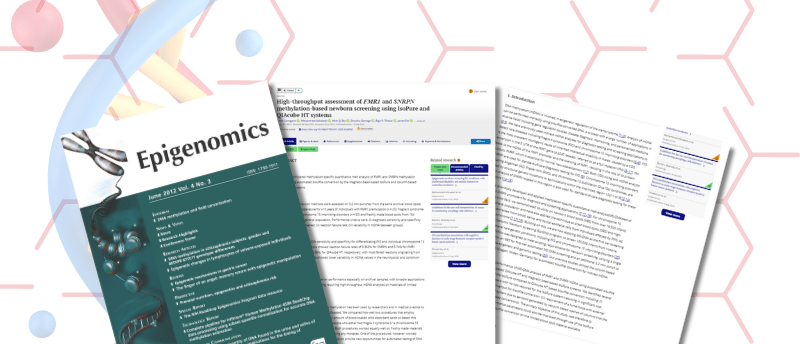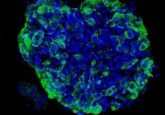Peek behind the paper: High-throughput assessment of FMR1 and SNRPN methylation-based newborn screening using IsoPure and QIAcube HT systems


David Godler is the group leader of the diagnosis and development laboratory at the Murdoch Children’s Research Institute (MCRI; Parkville, Australia). In this role, David has developed different approaches for diagnostic and screening applications. His lab has conducted several unique rare disease cohort studies, which have driven forward our understanding of many aspects of fragile X syndrome (FXS) and chromosome 15 imprinting disorders. He has also led one the world’s largest prevalence studies for FXS and chromosome 15 imprinting disorders, providing evidence to support the expansion of current newborn screening practices for these conditions.
David is also the founder and leader of the Australian Biobank for Chromosome 15 Imprinting Disorders and the lead of the Ep-iGenomic Newborn screening (EpiGNs) program, screening a whole-of-state birth cohort study called Gen V to investigate the benefits of an extended epigenomic newborn screening workflow, developed by his group.
Here, David explains the motivations behind his recent methods paper, published in Epigenomics, evaluating the use of his new robotics-based workflow to screen for FXS and chromosome 15 imprinting disorders.
Please provide a short summary of your paper
Newborns and children are routinely tested for a range of genetic diseases and many of these tests involve the analysis of DNA methylation patterns. In this world-first study, we compared how well two procedures featuring robotics could be used for high-throughput quantitative testing for changes in DNA methylation associated with different rare diseases.
We tested blood from infants and children soaked onto absorbent cards, using these two high-throughput procedures to detect these methylation changes. The blood samples on these cards were taken from participants with FXS or a chromosome 15 imprinting disorder, or from participants with neither of these conditions.
Both procedures worked equally well on fresher samples to correctly identify affected individuals, but one procedure, utilizing a robot called IsoPure, worked better on older blood samples.
What inspired you to develop this new method?
There is a great need for increased throughput and cost savings in large-scale testing across the board, but this need is increased in newborn screening due to the added confound of the limited blood spot material available. In advance of this study, we identified several potential advantages of the IsoPure robot compared to the QIAcube HT, which we have used in our earlier studies. These advantages include the cost savings associated with decreased use of plasticware, as no tips are required for the IsoPure system, alongside the fact that the IsoPure approach delivers a throughput double that of QIAcube HT system for bisulfite conversion.
Most importantly, however, the QIAcube HT robot requires a fumehood with external suction, due to the vacuum-based washes of columns, which generate aerosols of chemical used in the procedure.
This is not the case with the magnetic bead-based conversions utilized by IsoPure. Thus, our primary objective in this study was to determine if screening performance parameters with the IsoPure magnetic-bead method were the same or better than those using the column-based QIAcube HT system on the limited blood spot material available to us for newborn screening.
What impact do you hope it will have on laboratory researchers?
For us, the study results provide an opportunity to use an improved first-tier screening test in the EpiGNs program, which aims to screen 100,000 infants from Victoria, Australia, for several rare genetic conditions, including FXS and chromosome 15 imprinting disorders.
More broadly, the results provide new opportunities for automated testing of DNA that may be of limited quantity and quality, to detect many different diseases associated with changes to DNA methylation. This has the potential to help researchers, medical scientists and clinicians to screen and diagnose different diseases by targeting DNA methylation as part of a high-throughput low-cost methodology.
Do you have any tips for best practice for researchers looking to use this method?
The methodology is surprisingly straightforward, requiring little additional training or additional laboratory space. The IsoPure machine is quite compact compared to other robotics used in our lab. One of my tips for best practice would be to make sure that pre- and post-PCR materials are kept separated to minimize the potential for contamination. This is very important for high-throughput applications, such as newborn screening, which use the methodology described in this publication. Making sure that working solutions are pre-aliquoted prior to being frozen and that bisulfite-conversion plates are not subjected to more than one freeze-thaw cycle is also quite important.
What are you hoping to do next in this area?
In the next 3 years, we hope to complete the scope of work planned for the initial panel of conditions we have screened for on 100,000 Australian infants in the EpiGNs program to demonstrate the feasibility of this approach at a population scale. This will prove essential for these approaches to be considered for inclusion in the standard of care for newborn screening in the future.
In parallel, we are working on expanding the panel of conditions screened. There are over 120 rare diseases where changes in DNA sequence are associated with changes to DNA methylation. So, we are planning to utilize the high-throughput approach described in this methods paper for new screening and diagnostic applications in many of these conditions.
Some the conditions screened in the EpiGNs program, like Angelman syndrome, have treatments currently in Phase II/III clinical trials. However, these trials are typically conducted in older children as the current standard of care testing for these conditions relies on the recognition of symptoms, delaying diagnosis until patients are older. If a validated screening approach for these conditions can be established, then we could identify infants affected with these conditions before symptoms become apparent. This would allow for infants to be involved in future clinical trials, maximizing the potential benefits to them and potentially improving the performance of these trials in younger participants.
David’s further positions include Assistant Professorships at the Department of Paediatrics, University of Melbourne and the Department of Paediatrics, Monash University (both Melbourne, Australia).
Disclosures
David Godler has reported his disclosures of relevance to the topics discussed in this feature. They are as follows:
- He is an inventor on patents related to the technologies described in this publication
- Executive director of EDG Innovations & Consulting, which receives funds from this intellectual property.
- He has also acted as a paid consultant for Bellberry, Ltd and Actinogen Medical, Pty, Ltd.





